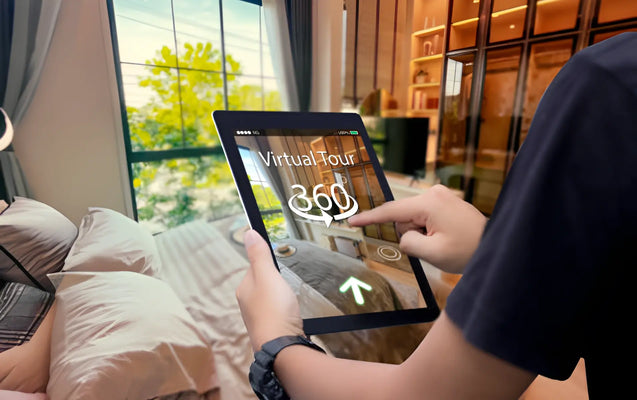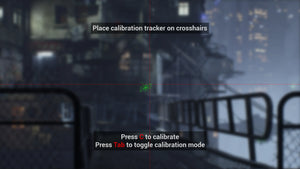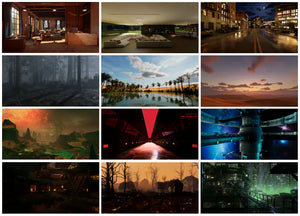What is a Virtual Tour?

In today’s digital-first world, people crave immersive, interactive experiences that go beyond static images or text. This is where virtual tours come in. But what is a virtual tour, exactly?
A virtual tour is a simulation of an existing location or environment that allows viewers to explore it digitally, often through 360° images, videos, or 3D renderings. Unlike traditional photography, a virtual tour gives users the feeling of actually being inside a place, navigating freely at their own pace.
From real estate and retail to education and tourism, virtual tours are transforming industries and reshaping how businesses connect with audiences. With virtual production technologies like those pioneered by ARwall, these experiences are becoming more dynamic, hyper-realistic, and widely accessible.
How Does a Virtual Tour Work?
A virtual tour works by combining panoramic photography, 3D modeling, or video production with software that stitches everything into an interactive experience.
Here’s a simplified breakdown:
-
Capture – Photographers use 360° cameras or specialized software to capture every angle of a space.
-
Stitching – The images or videos are stitched together into a seamless, panoramic environment.
-
Interactivity – Hotspots, clickable elements, and navigation arrows are added to allow exploration.
-
Deployment – The finished tour is hosted online, often accessible via desktop, mobile, or even VR headsets.
This technology makes it possible to “walk through” an apartment, explore a university campus, or even tour a museum, without physically being there.
What is the Purpose of a Virtual Tour?
The purpose of a virtual tour is to give people remote access to spaces they can’t visit in person. It enhances decision-making, builds trust, and improves engagement.
For example:
-
A virtual tour of an apartment helps potential renters or buyers evaluate the space before scheduling a physical visit.
-
A virtual tour for students allows international applicants to explore university campuses from thousands of miles away.
-
Businesses use virtual tours online to showcase products, stores, or venues in ways that static brochures or photos simply cannot match.
At its core, the purpose is to bridge the gap between physical and digital worlds—something that aligns perfectly with the virtual production revolution driven by ARwall.

Advantages of Virtual Tours
The advantages of virtual tours are extensive, making them essential tools across industries.
-
Accessibility: Anyone with an internet connection can access a space instantly.
-
Convenience: Saves time for customers and businesses by reducing unnecessary site visits.
-
Engagement: Immersive storytelling captures attention better than static content.
-
Transparency: Builds trust by showing spaces as they are, reducing surprises.
-
Cost-effectiveness: A one-time investment in creating a virtual tour can drive long-term engagement.
Businesses that embrace virtual tours online see improved conversion rates, higher customer satisfaction, and stronger brand loyalty.
Virtual Tour Examples
Some compelling virtual tour examples include:
-
Real Estate: Explore a luxury apartment in 3D before scheduling a visit.
-
Education: Take a campus tour of Harvard or Oxford without leaving your home.
-
Retail: Enter a virtual store, browse products, and even “try” them before purchase.
-
Tourism: Visit the Louvre Museum or the Great Wall of China virtually.
-
Event Spaces: Check out wedding venues or conference halls before booking.
These virtual tour examples demonstrate the versatility of the medium. With companies like ARwall, virtual production pushes these experiences further by combining photorealistic environments with interactive storytelling.
Virtual Tour for Students
The use of virtual tours in education has been one of the most impactful trends. Universities and schools worldwide now offer immersive campus tours online.
For students:
-
They provide a feel of campus life without expensive travel.
-
International students can evaluate facilities before applying.
-
Virtual classrooms and labs extend learning beyond traditional boundaries.
This also supports inclusivity, giving students in remote areas access to resources they might not otherwise have. Virtual reality in education, powered by virtual production, is helping democratize learning at scale.

Virtual Tour of an Apartment
Real estate has embraced virtual tours more than almost any other sector. A virtual tour of an apartment allows potential renters or buyers to examine every corner, from the living room layout to the kitchen design, without stepping foot inside.
With ARwall’s camera tracking and virtual production solutions, real estate professionals can enhance these tours with cinematic storytelling—showing a family enjoying the space, adjusting lighting for different moods, or virtually staging furniture to match a client’s taste.
What is a Virtual Tour App?
A virtual tour app is software designed to create, view, or share virtual tours. Some apps are designed for real estate professionals, while others serve industries like tourism or education. Popular features include 360° navigation, hotspots for information, VR headset compatibility, and integration with social media or websites.
As AR and VR adoption grows, expect virtual tour apps to integrate with virtual production technologies, enabling businesses to offer even more interactive, customizable, and engaging experiences.
How to Make a Virtual Tour
The process of creating a virtual tour depends on the tools and goals:
-
Choose Equipment: Start with a 360° camera or smartphone app.
-
Capture the Space: Photograph or video every angle.
-
Use Software: Stitch the images together using software like Matterport, Kuula, or 3DVista.
-
Add Interactivity: Insert hotspots, info points, and navigation paths.
-
Publish Online: Host the tour on a website or app, ensuring it’s mobile-friendly.
For businesses, working with companies like ARwall adds a cinematic layer. Using virtual production technology, you can craft more immersive, Hollywood-level environments, blending reality with digital enhancements.
Virtual Production’s Role in Virtual Tours
So, where does ARwall come in? Virtual tours have traditionally been static—mostly stitched photos or videos. But with virtual production, they are evolving into cinematic experiences.
-
Immersive storytelling: Instead of simply moving through a space, users are guided through narratives with dynamic environments.
-
Real-time rendering: Technologies like Unreal Engine allow instant adjustments in lighting, backgrounds, and interactivity.
-
Scalability: One setup can generate multiple tours, scenarios, or branded experiences.
For example, instead of just viewing a virtual apartment, potential buyers can change wall colors, adjust lighting, or even see how the space looks at different times of day—all powered by real-time camera tracking and ARwall’s innovations.
Virtual Reality and Virtual Tours in Retail
The use of virtual reality in retail is a natural extension of the virtual tour concept. Retailers are using VR to give customers the chance to “walk through” virtual stores, try products, and interact with immersive shopping environments without leaving their homes.
-
Virtual reality in retail stores lets customers explore products as if they were in a physical location.
-
Shoppers can test furniture in their living rooms using AR or preview clothing styles in a virtual fitting room.
-
Retailers benefit by reducing returns, increasing engagement, and offering customers a more personalized shopping journey.
ARwall’s virtual production technology allows retailers to push this even further—creating cinematic, real-time shopping experiences where products are presented in a story-driven, highly interactive format.
Business and Tourism: Expanding Access Through Virtual Tours
Virtual Reality in Business
Businesses use virtual tours online to present offices, factories, or event venues to potential clients and investors. This not only builds trust but also streamlines decision-making.
-
Corporate real estate is marketed more efficiently.
-
Event venues provide virtual walk-throughs for clients booking conferences or weddings.
-
Manufacturing plants offer investors behind-the-scenes access without travel.
Virtual Tours in Tourism
Tourism has been revolutionized by virtual tour examples like the Louvre, the Colosseum, and the Pyramids of Giza being accessible digitally. This not only excites travelers before they book but also preserves cultural experiences for those who cannot travel.
ARwall adds to this with real-time rendering that can bring ancient monuments or tourist attractions to life with interactive narratives. Imagine a tourist virtually exploring Rome, complete with dynamic reconstructions of how the city looked 2,000 years ago—this is the future ARwall is building.
The Future of Virtual Tours
When asking, “What is the future of VR in retail, real estate, and beyond?”, the answer is clear: it lies in virtual production and real-time technology.
-
Greater personalization – Users will be able to tailor virtual tours to their preferences, such as viewing an apartment in different layouts or colors.
-
AI-driven interactivity – Virtual guides powered by AI can narrate, answer questions, and provide real-time support.
-
Cross-platform accessibility – Tours will be accessible on mobile, desktop, VR headsets, and even AR glasses.
-
Cinematic storytelling – Thanks to ARwall, virtual tours won’t just be navigations—they will be interactive, cinematic experiences that immerse users into branded stories.
The future is not just about seeing a space but about experiencing it in ways that influence emotions, behaviors, and decisions.
Virtual Tours and Market Growth
The virtual reality in retail market size, along with real estate and tourism, is projected to grow exponentially in the next decade. Businesses are investing in virtual reality in retail market analysis and forecast studies, which show rising consumer demand for immersive experiences.
-
The virtual reality in retail market share is expected to expand as more companies adopt VR-driven solutions.
-
Real estate firms already report higher conversion rates for properties with virtual tours online.
-
Education and corporate sectors are integrating virtual classrooms and training environments at scale.
ARwall is positioning itself at the center of this growth by providing virtual production tools that make these experiences more accessible, customizable, and cinematic.
ARwall’s Role in Shaping the Future of Virtual Tours
Traditional virtual tours give you a view of a place. ARwall’s virtual production tools go further by transforming how these tours are created and experienced:
-
Cinematic Quality: Using Hollywood-grade tools like Unreal Engine and real-time rendering.
-
Scalable Solutions: From small businesses to global enterprises, ARwall tailors experiences to match brand needs.
-
Immersive Storytelling: Every virtual tour becomes a story, not just a space, making users feel emotionally connected.
-
Virtual Production Innovation: By blending AR, VR, and real-time camera tracking, ARwall ensures virtual tours evolve from static simulations into living, interactive experiences.
This is why ARwall is a trusted partner across industries—from retail and real estate to entertainment and education.
FAQs About Virtual Tours
Q1. How does a virtual tour work?
A virtual tour combines 360° photography, 3D modeling, or video with interactive software that allows users to explore a space digitally.
Q2. What are the advantages of virtual tours?
They save time, increase accessibility, engage audiences, and build trust while offering a cost-effective way to showcase spaces.
Q3. Can I create my own virtual tour?
Yes, with 360° cameras and software like Matterport, Kuula, or 3DVista. For businesses, professional solutions like ARwall deliver cinematic quality.
Q4. What is the purpose of a tour?
The purpose of a virtual tour is to provide remote access to a space, enabling better decision-making and enhancing customer experiences.
Q5. What are some virtual tour examples?
Real estate apartments, retail stores, university campuses, museums, and tourist attractions like the Louvre or the Pyramids of Giza.
Q6. What is a virtual tour app?
It’s software that creates or hosts virtual tours, often including interactivity, VR headset compatibility, and online sharing features.
Q7. What is a virtual tour of an apartment?
A digital simulation of an apartment that allows potential buyers or renters to explore the layout and design remotely.
Q8. How to make a virtual tour?
Capture 360° photos or videos, stitch them together in software, add interactivity, and publish online. Businesses enhance results by using ARwall’s virtual production.
Q9. What is the future of VR in retail?
Retail will increasingly adopt VR and AR to offer personalized shopping experiences, with ARwall driving cinematic, real-time interactivity.
Q10. What is virtual retailing?
Virtual retailing is the use of VR and AR to create immersive shopping experiences where customers can browse, interact, and purchase products digitally.
Final Thoughts
So, what is a virtual tour? It’s more than just an online walkthrough—it’s the future of how we explore, shop, learn, and connect. The advantages are undeniable: increased accessibility, higher engagement, and improved decision-making.
But the real transformation lies in virtual production. Companies like ARwall are taking virtual tours beyond static photography, making them immersive, cinematic, and interactive experiences that change how industries connect with audiences.
Whether it’s a virtual tour of an apartment, a virtual reality retail store, or an educational campus experience, ARwall’s innovations are shaping a new standard for digital interaction. The future of virtual tours is here—and it’s being built in real time.





